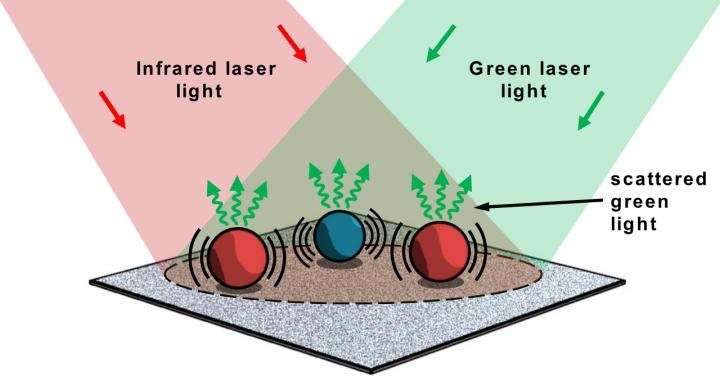Jan 6 2017
 Multiple species of micron-sized particles are simultaneously illuminated by an infrared laser and a green laser beam. Absorption of the infrared laser light by the particles increases their temperatures, causing them to expand and slightly altering their optical properties. These changes are unique to the material composition of each particle and can be measured by examining the modulation of scattered green light from each particle. CREDIT Ryan Sullenberger, MIT Lincoln Laboratory
Multiple species of micron-sized particles are simultaneously illuminated by an infrared laser and a green laser beam. Absorption of the infrared laser light by the particles increases their temperatures, causing them to expand and slightly altering their optical properties. These changes are unique to the material composition of each particle and can be measured by examining the modulation of scattered green light from each particle. CREDIT Ryan Sullenberger, MIT Lincoln Laboratory
A microscope to chemically identify individual micron-sized particles has been developed by a team of researchers. This new approach could be used in airports or various other high-security venues as a highly sensitive and inexpensive way to rapidly screen people for microscopic amounts of potentially hazardous materials.
Researchers from the Massachusetts Institute of Technology’s Lincoln Laboratory, USA, presented a report in the journal Optics Letters, from The Optical Society (OSA). In this report, the researchers demonstrated their new microscope by measuring infrared spectra of individual 3-micron spheres developed from acrylic or silica.
The new technique uses a simple optical setup comprising of compact components capable of allowing the instrument to be miniaturized into a portable device, which is almost the size of a shoebox.
The most important advantage of our new technique is its highly sensitive, yet remarkably simple design. It provides new opportunities for nondestructive chemical analysis while paving the way towards ultra-sensitive and more compact instrumentation.
Ryan Sullenberger, Associate Staff at MIT Lincoln Labs
The microscope can be used to detect controlled substances or chemical threats in a rapid manner due to its ability to identify individual particles. Its high sensitivity enables it to be ideal for scientific analysis of extremely small samples or for measuring the optical properties of materials.
Probing Spectral Fingerprints
Infrared spectroscopy is normally used to detect unknown materials as approximately all materials can be detected by its unique fingerprint, or infrared absorption spectrum. This infrared fingerprint can be detected by this technique without using infrared detectors. These detectors add a major bulk to standard instruments which is limiting for portable devices due to their requirement for cooling.
The new technique operates by illuminating particles with both a green laser and an infrared laser. Energy is deposited into the particles by the infrared laser, causing them to get heated and then expand. This is followed by scattering of the green laser light by these heated particles. This scattering is monitored by a visible-wavelength camera, which also tracks physical changes of the individual particles through the lens of the microscope.
The instrument is used to identify the material composition of every single particle by tuning the infrared laser to varied wavelengths and then collecting the visible scattered light at every single wavelength. The technique is considered to be suitable for non-destructive analysis because of the fact that slight heating of the particles does not impart any permanent modifications to the material.
Photothermal modulation of Mie scattering has been used since the 1980s. This process has the ability to excite particles with infrared light and then focus on their scattering with visible wavelengths. More advanced optical components are used by this work in order to develop and detect the Mie scattering. This work is the first to use an imaging configuration to identify multiple species of particles.
We're actually imaging the area that we're interrogating. This means we can simultaneously probe multiple particles on the surface at the same time.
Alexander Stolyarov, Technical Staff at MIT Lincoln Lab
The utilization of visible wavelengths for imaging by the new microscope provides it with a spatial resolution of almost 1 micron, in comparison to the roughly 10-micron resolution of standard infrared spectroscopy methods. This increased resolution permits the new method to both distinguish and identify separate particles that are very small and close together.
“If there are two very different particles in the field of view, we’re able to identify each of them,” said Stolyarov. “This would never be possible with a conventional infrared technique because the image would be indistinguishable.”
Compact, Tunable Infrared Laser
A major enabling technology for the new method refers to the development of compact, tunable quantum cascade infrared lasers. A quantum cascade laser was combined with a commercially available scientific-grade camera and an extremely stable visible laser source.
We are hoping to see an improvement in high-power wavelength-tunable quantum cascade lasers. A more powerful infrared laser enables us to interrogate larger areas in the same amount of time, allowing more particles to be probed simultaneously.
Ryan Sullenberger, Associate Staff at MIT Lincoln Labs
The team has planned to test their microscope on additional materials, including non-spherical shaped particles. The researchers also plan to test their setup in environments that are more realistic and that might contain interferents in the form of particles that are not from the chemical of interest.
“The presence of interferents is perhaps the biggest challenge I anticipate we will need to overcome,” said Stolyarov. “Although contamination is a problem for any technique measuring absorption from small amounts of materials, I think our technique can solve that problem because of its ability to probe one particle at a time.”